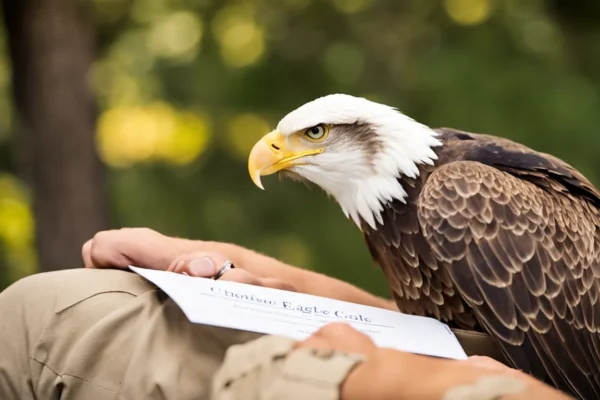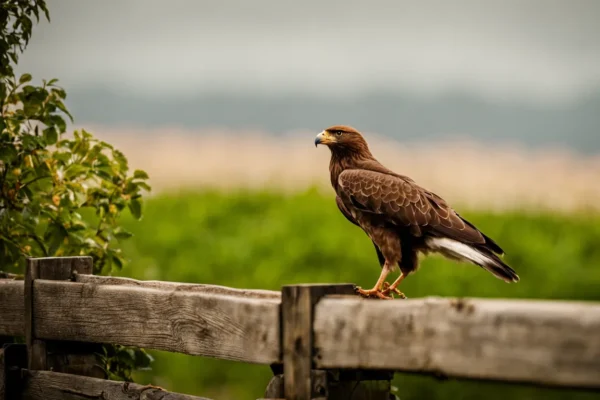The male peacock might steal the spotlight with its vibrant colors and extravagant display, but let’s not forget about the female peacock, also known as a “peahen.” While she may not boast the same flamboyant appearance as her male counterpart, the peahen possesses her own unique beauty and charm.
Unlike the dazzling and colorful plumage of the male, the peahen showcases softer, brownish-gray feathers and lacks the iconic long tail. However, her role is just as crucial in the grand scheme of things. The peahen takes on the responsibility of raising and safeguarding her adorable offspring, known as “peachicks.”
Despite not having the flashy appearance of the male, the peahen plays a tough and essential role in ensuring the survival of her species. Her dedication to caring for the peachicks contributes significantly to the continued existence of these remarkable birds.
To delve deeper into the distinctions between male and female peacocks, explore the details in this article!
Male Peacocks vs. Female Peacocks
Visual Differences
Male
Adults typically measure 7.5 feet in length, including the tail, and weigh 9 to 13 pounds (4-6 kg).
- Lifespan: 20 years or more
- Not family-friendly
- Other pet-friendly: Infrequently
Female
Adults typically measure 3.5 feet in length, including the tail, and weigh 6 to 9 pounds (2.7 to 4 kg).
- Lifespan: 20 years or more
- Not recommended for families
- Other pet-friendly: Infrequently
Coloring
The coloring of the two sexes of peafowl is the most noticeable distinction. The males are the most alluring of the two, with vivid blue and/or green feathers that, when they are completely extended, are difficult to look away from. During mating season, their vivid feathers are intended to entice females.
Feathers on female peafowl are often less vibrantly colored and blue or green than those on males. Many females have dark or grey feathers, which aid them in hiding from predators when they approach too closely. Peahens have white bellies, while peacocks have blue or green stomachs to match their plumage.
Sizing
The size of a peafowl might also reveal the sex of the bird. Peacocks normally weigh between 9 and 13 pounds once they reach adulthood and are substantially bigger than peahens. Females often weigh 6 to 9 pounds. When fully grown, peafowl males are also around a foot longer than females.
Another distinction is tail size. The peacock has a long, colorful tail that may reach a staggering length of 75 inches. Females have tails that are between 2 and 6 inches shorter. They are unable to spread their tails out like their male colleagues because their tail feathers are dull. During mating season, the male’s tail comes in useful and aids in providing protection from predators.
Neck and Head
The blue feathers on a peacock’s long, graceful neck resemble silky fur. Peahens also have long necks, but they have feathers that resemble scales more than fur since they are often blue or green in color. Boys cannot fluff the feathers on their necks as girls can. Additionally, their ocular markings vary somewhat.
Both sexes have prominent white markings above and below the eyes, however, the markings under the eyes of females usually match the color of their skin, making them harder to discern than those beneath the eyes of males. Additionally, a peafowl’s head crest has different feathers according to sex. Long shafts that protrude from the bird’s head make up the crest, which is topped with sparsely packed feather clusters. Boys normally have blue crest feathers, while females commonly have brown or tan ones.
Actions
Male and female peafowl behave differently throughout the day. Males spread their tails out anytime they wish to attract a female’s attention or make a good impression. When battling with other peahens or warning another peafowl of danger nearby, females ruffle their tail feathers rather than fan them. While females care for the young and construct nests throughout the day, males spend the majority of their time alone. Peafowl females tend to be friendlier than males, but they are also often more territorial.
How can you distinguish a male from a female peacock?

Peafowl is either male or female; peahens are the latter. They may easily be distinguished from one another because the males have enormous tail feather trains and are incredibly colorful, while the females are mostly light brown.
Peafowl exhibits remarkable sexual dimorphism, in which the male and female have entirely distinct appearances. The male peacock is instantly recognizable and distinctive because of its stunning, multicolored metallic plumage and a very long train of tail feathers that are embellished with “eyes.”
The female peahen, on the other hand, has considerably more subdued coloring. Adult peahens have green metallic necks, rufous-brown heads with crests like those of the males, and dark brown breasts with glossy green accents. Whitened underparts are present. The tail train of the female, which is scaly or mottled with brown, light brown, and copper, is significantly shorter than that of the male.
Males are also heavier and bigger than females. The male’s body length normally ranges from 100 to 115 cm (39 to 45 in), but with its tail train, it may reach an amazing 195 to 225 cm (77 to 89 in) in length. Males typically weigh between 4 and 6 kg (8.8 and 13.2 lb). The female peahens are around 95 cm (37 in) long and weigh between 2.75 and 4 kg (6.1 and 8.8 lb).
Are peacock females larger than males?
Contrary to popular belief, female peafowl are not larger than males. When the enormous tail train is taken into account, male peacocks measure over 2 to 2.3m (6 to 7ft) in length. In contrast, the peahen has a tail train that is significantly shorter and is between 90 cm to 1 m in length.
Additionally, the male weighs between 4 and 6 kg compared to the female’s 2.75 to 4 kg.
Behavioral variations
There are significant behavioral distinctions between male and female peacocks, including some rather intriguing courting and breeding strategies, which we’ll discuss in more depth below.

Selective sex and courting
Peafowl males mate with a harem of three to five females and are polygamous. Males show during the stunning courting dance by lifting their tails into a big arching fan. Then he rattles and vibrates his long feathers while holding his wings partially extended. This causes a noticeable ruffling sound. After that, the peacock circles the female and displays his feathers.
Peafowl society is fairly remarkable, and early naturalists like Charles Darwin were perplexed by the variations between males and females. “The sight of a feather in a peacock’s tail, whenever I gaze at it, makes me sick,” Darwin wrote to the American botanist Ada Grey.
Darwin found it puzzling as there seemed to be almost no justification for the elaborateness of the peacock’s plumage. Darwin questioned why the peacock had developed a particularly bulky tail that rendered it more vulnerable to predators because many sexual dimorphisms are ornamental or don’t affect the survival of the species. Peacocks inspired Darwin to create his theory of sexual selection since he was skilled at resolving such problems in evolution.
Darwin proposed that a domino effect of evolutionary changes would result from females repeatedly choosing the males with the most ornate plumage. Although the majority of studies show that women are not very concerned with picking men with the largest trains, most eyes, etc., researchers still feel that this is the case. Therefore, it is nearly a given that peacocks developed for sexual selection, albeit it is still unclear how they managed to become so complex.
Raising children
A peacock does not stay around to help in raising the babies after mating with a peahen.
For around 27 to 30 days, the female incubates the eggs while almost ever exiting to eat or drink. The female may lose a significant amount of weight during this period. She ferociously protects the eggs and engages in combat with anything that enters a 2-meter range.
The juvenile peafowl, known as peachicks, can walk within hours of the eggs hatching. They follow their mother around as she pecks to indicate what they may eat.
During this period, the mother keeps a close eye on her brood and works to keep them in close proximity to the greenery. Almost little male participation is seen in raising the chicks. Rarely, the male has been seen incubating the eggs, maybe in her place after the female passed away.
Vocalizations and calls
According to descriptions, the peacock’s primary cry, may-awe, is a rough, powerful trumpet-like noise. Another of their cries, ka-aan, resembles a string of piercing shrieks or screams that are quickly repeated. When the female is ready for copulation, the male likewise ‘hoots’.
The mother hen’s furious metallic kok-kok and kha-kha-kha are distinct from the sounds made by the female.
Can female peacocks rear their young on their own?
Peahen females rear their young on their own in the wild. After mating, the peahen separates herself from males and other peahens and bears her young by herself.
The mother raises the chicks for up to 9 months until they are totally independent after incubating the eggs for around 30 days.
Although wild peahens are highly devoted single moms, in captivity their maternal instincts are sometimes relatively weak. Some peahens that are maintained in captivity show little to no interest in their young.
Can a female peacock fly?
Peafowl females have the same ability to fly as males.
Their shorter, lighter tails may enable them to take off more quickly! Peafowl are adept short-distance fliers, although they typically only take off for a perch on a tree.
Do female peacocks spread their feathers?
Despite having a train of feathers, female peafowl lack it in comparison to males. Additionally, they lack the male’s tail feathers’ fan-like shape.
Are peacock females colorful?
Some of the top regions and necks of female peacocks do have a metallic green gloss to them.
They are nevertheless lovely, stunning, huge birds with plenty of aesthetic features despite not having the same spectacular plumage as the male!





![Amazing Birds with White Heads [Images + IDs]](https://birdsology.com/wp-content/uploads/2024/01/white-headed-robin-chat-600x400.jpg)
2 thoughts on “Male vs Female Peacock [Everything you need to know]”